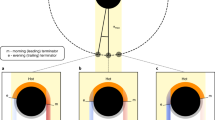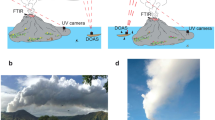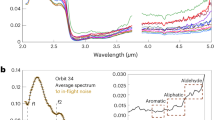Abstract
Volcanic gases provide important insights into deep-Earth processes, and gas composition and flux variations show promise as predictors of eruptive activity1,2,3. But data correlating gas composition with eruptions are sparse, largely because such studies have traditionally involved direct sampling inside a volcanic crater — a hazardous operation that has resulted in numerous deaths4,5. Crater-rim-based spectroscopy6,7,8,9, closed-path spectroscopy of gases sampled from aircraft10, and time-averaged studies using volatile traps11,12,13 allow measurements to be taken from safer distances. But when a full-scale explosive eruption threatens, even these methods become dangerous as the hazard radius expands to many kilometres. Previously, only sulphur dioxide has been reliably measurable at such large distances, using correlation spectroscopy14. Here we describe techniques that extend the useful range of passive infrared spectroscopy to monitor many gases at distances of over 17 km. We demonstrate the use of these techniques in a high-temporal-resolution study of short-term compositional variations associated with an explosive eruption at Mexico's Popocatépetl volcano on 25–26 February 1997. We observed a steady increase in SiF4/SO2 over several days preceding the eruption, followed by a tenfold decrease in this ratio over a few hours immediately afterwards.
This is a preview of subscription content, access via your institution
Access options
Subscribe to this journal
Receive 51 print issues and online access
$199.00 per year
only $3.90 per issue
Buy this article
- Purchase on Springer Link
- Instant access to full article PDF
Prices may be subject to local taxes which are calculated during checkout



Similar content being viewed by others
References
Allard, P. in Forecasting Volcanic Events (eds Tazieff, H. & Sabroux, J.-C.) 337–394 (Elsevier, Amsterdam, (1983)).
Fischer, T. P. et al. Correlation between SO2flux and long-period seismicity at Galeras volcano. Nature 368, 135–137 (1994).
Tedesco, D. Monitoring Active Volcanoes (eds McGuire, B., Kilburn, C. & Murray, J.) (UCL Press, London, (1995)).
Kerr, R. A. Volcanologists ponder a spate of deaths in the line of duty. Science 260, 289–290 (1993).
Baxter, P. J. & Gresham, A. Deaths and injuries in the eruption of Galeras Volcano, Colombia, 14 January 1993. J. Volcanol. Geotherm. Res. 77, 325–338 (1997).
Francis, P., Chaffin, C., Maciejewski, A. & Oppenheimer, C. Remote determination of SiF4in volcanic plumes: A new tool for volcano monitoring. Geophys. Res. Lett. 23, 249–252 (1996).
Francis, P., Maciejewski, A., Oppenheimer, C., Chaffin, C. & Caltabiano, T. SO2:HCl ratios in the plumes from Mt. Etna and Vulcano determined by Fourier transform spectroscopy. Geophys. Res. Lett. 22, 1717–1720 (1995).
Mori, T. & Notsu, K. Remote CO, COS, CO2, SO2, HCl detection and temperature estimation of volcanic gas. Geophys. Res. Lett. 24, 2047–2050 (1997).
Stix, J., Morrow, W., Nicholls, R. & Charland, A. Infrared remote sensing of CO and COS gas emitted by the Galeras Volcano, Colombia, January 8–10, 1993. Can. J. Remote Sens. 22, 297–304 (1996).
McGee, K. A. & Gerlach, T. M. Airborne volcanic plume measurements using a FTIR spectrometer, Kilauea volcano, Hawaii. Geophys. Res. Lett. 25, 615–618 (1998).
Noguchi, K. & Kamiya, H. Prediction of eruptions by measuring the chemical composition and amount of gases. Bull. Volcanol. 24, 367–378 (1963).
Italiano, F., Nuccio, P. M., Pecoraino, G. & Valenza, M. Monitoring of acid gases at the crater of Vulcano using the method of the alkaline traps. Acta Vulcanol. 1, 249–254 (1991).
Goff, F. et al. Geochemical surveillance of magmagtic volatites at Popocatépetl Volcano, Mexico. Geol. Soc. Am. Bull 110, 695–710 (1998).
Realmuto, V. J., Sutton, A. J. & Elias, T. Multispectral thermal infrared mapping of sulfur dioxide plumes: A case study from the East Rift Zone of Kilauea Volcano, Hawaii. J. Geophys. Res. B 107, 15057–15072 (1997).
Naughton, J. J., Derby, J. V. & Glover, R. B. Infrared measurements on volcanic gas and fume: Kilauea eruption, 1968. J. Geophys. Res. 74, 3273–3277 (1969).
Mori, T., Notsu, K., Tohjima, Y. & Wakita, H. Remote detection of HCl and SO2in volcanic gas from Unzen volcano, Japan. Geophys. Res. Lett. 20, 1355–1358 (1993).
Mori, T. et al. Remote detection of fumarolic gas chemistry at Vulcano, Italy, using an FT-IR spectral radiometer. Earth Planet. Sci. Lett. 134, 219–224 (1995).
Notsu, K., Mori, T., Igarishi, G., Tohjima, Y. & Wakita, H. Infrared spectral radiometer: A new tool for remote measurement of SO2of volcanic gas. Geochem. J. 27, 361–366 (1993).
Nixon, G. T., Demant, A., Armstrong, R. L. & Harakal, J. E. K-Ar and geologic data bearing on the age and evolution of the Trans-Mexican Volcanic Belt. Geofis. Int. 26, 109–158 (1987).
Robin, C. Le volcan Popocatépetl (Mexique): structure, evolution petrologique et risques. Bull. Volcanol. 47, 299–315 (1984).
Siebe, C., Abrams, M., Macias, J. L. & Obenholzner, J. Repeated volcanic disasters in Prehispanic time at Popocatépetl, central Mexico: Past key to the future? Geology 24, 399–402 (1996).
Waitz, P. Popocatépetl again in activity. Am. J. Sci., 5th ser. 1(1), 81–83 (1921).
Delgado, H. & Cárdenas-G., L. in Volcanic Activity and the Environment (abstr.) 49 (IAVCEI, Puerto Vallarta, Mexico, (1997)).
Delagdo, H., Venegas, J. J., Cárdenas, L. & Doukas, M. Explosive eruption hazards at Popocatépetl Volcano (Mexico): The SO2flux measurements insight to the problem. Geol. Soc. Am. Annu. Meeting, Prog. Abstr. A–109 (1995).
Stimac, J. A., Siebe, C. & Schaaf, P. in Volcanic Activity and the Environment (abstr.) 76 (IAVCEI, Puerto Vallarta, Mexico, (1997)).
De la Cruz, S. & Siebe, C. The giant Popocatépetl stirs. Nature 388, 227 (1997).
Fowler, J. B. Athird generation water bath based blackbody source. J. Res. Natl Inst. Stand. Technol. 100, 591–599 (1995).
Love, S. P. et al. Integrated infrared/UV/LIDAR remote sensing of volcanic emissions at White island and Mt. Ruapehu, New Zealand. (Abstr.) Eos 77, F802 (1996).
Kyle, P. R., Sybeldon, L. M., McIntosh, W. C., Meeker, K. & Symonds, R. in Volcanological and Environmental Studies of Mount Erebus, Antarctica (ed. Kyle, P. R.) 69–82 (Am. Geophys. Union, Washington DC, (1994)).
Hanst, P. L., Hanst, S. T. & Williams, G. M. Infrared Spectra for Quantitative Analysis of Gases (QASoft Database) (Infrared Analysis, Inc., Anaheim, CA, (1996)).
White, A. F. & Hochella, M. F. Surface chemistry associated with the cooling and subaerial weathering of recent basalt flows. Geochim. Cosmochim. Acta 56, 3711–3721 (1992).
Symonds, R. B., Reed, M. H. & Rose, W. I. Origin, speciation, and fluxes of trace-element gases at Augustine volcano, Alaska: insights into magma degassing and fumarolic processes. Geochim. Cosmochim. Acta 56, 633–657 (1992).
Symonds, R. B. & Reed, M. H. Calculation of multicomponent chemical equilibria in gas-solid-liquid systems: Calculation methods, thermochemical data and applications to studies of high-temperature volcanic gases with examples from Mount St. Helens. Am. J. Sci. 293, 758–864 (1993).
Acknowledgements
We thank R. Meli for access and logistical support, and P. G. Weber, S. Gerstl and D.Pettit for discussions on remote sensing applications. This work was supported by Laboratory Directed Research and Development (LDRD) grants (Remote Sensing Science) from Los Alamos National Laboratory, and by the Mexican National Center for Disaster Prevention (CENAPRED), the Mexican National Science and Technology Commission (CONACYT), and the Universidad Nacional Autónoma de México.
Author information
Authors and Affiliations
Corresponding author
Rights and permissions
About this article
Cite this article
Love, S., Goff, F., Counce, D. et al. Passive infrared spectroscopy of the eruption plume at Popocatépetl volcano, Mexico. Nature 396, 563–567 (1998). https://doi.org/10.1038/25109
Received:
Accepted:
Issue Date:
DOI: https://doi.org/10.1038/25109
This article is cited by
-
Design of Dual-Frequency Plasmonic Photo-Coupler for Infrared Phototransistors
Plasmonics (2021)
-
Applications of quantitative thermal infrared hyperspectral imaging (8–14 μm): measuring volcanic SO2 mass flux and determining plume transport velocity using a single sensor
Bulletin of Volcanology (2019)
-
Validating the accuracy of SO2 gas retrievals in the thermal infrared (8–14 μm)
Bulletin of Volcanology (2017)
-
Characterization and initial field test of an 8–14 μm thermal infrared hyperspectral imager for measuring SO2 in volcanic plumes
Bulletin of Volcanology (2016)
-
High SiF4/HF ratio detected in Satsuma-Iwojima volcano’s plume by remote FT-IR observation
Earth, Planets and Space (2014)
Comments
By submitting a comment you agree to abide by our Terms and Community Guidelines. If you find something abusive or that does not comply with our terms or guidelines please flag it as inappropriate.



